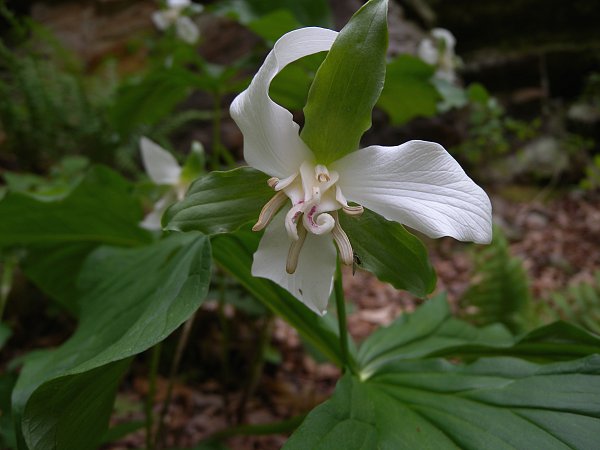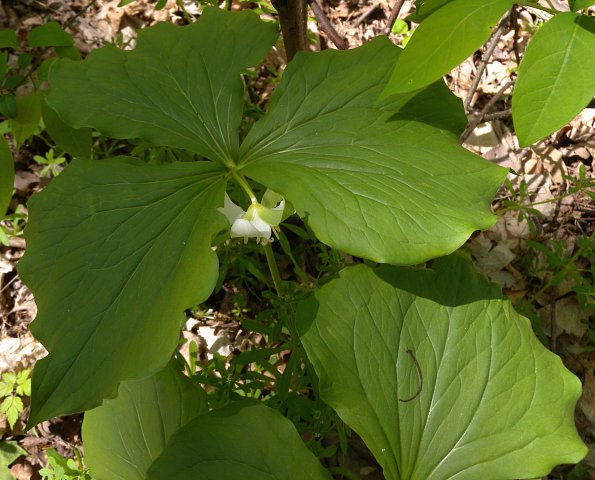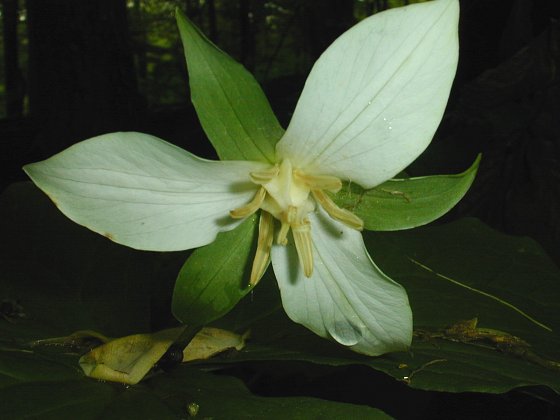Description: This herbaceous perennial plant is about 1½–2' tall; it consists of a central stalk with 3 spreading terminal leaves. The stalk is light green and hairless. The leaves are up to 6½" long and across; they are broadly obovate or broadly rhombic-oval, smooth along the margins, and hairless. The base of each leaf is wedge-shaped, while the terminal end tapers to a blunt tip. The major veins of each leaf are parallel; there are also branching side veins. A mature plant produces a single flower on a nodding peduncle about 1–2½" long. This flower is about 2" across, consisting of 3 white spreading petals, 3 green sepals, 6 stamens (anthers & filaments), and a creamy central ovary. The pale yellow anthers are twice as long as their filaments. At the tip of the ovary, there are 3 recurved stigmas. Only rarely are the petals of the flowers brownish purple. The flower hangs from its peduncle a little above or a little below the leaves.

The blooming
period occurs from mid- to late spring. The seed capsule that replaces
the flower is 6-angled; it splits open at maturity to release the
seeds. The foliage withers away during the summer. The vertical central
root is slightly swollen near the base of the plant; it branches into
secondary fibrous roots. Small vegetative colonies are occasionally
produced from spreading rhizomes.
Cultivation:
The preference is dappled sunlight during the spring, followed by light
to medium shade. The soil should be evenly moist, fertile, and loamy,
with a layer of decaying leaves on its surface to protect the plant
from drying out. Trilliums are slow to develop from seed and take many
years to reach maturity. Most growth and development occurs during the
spring before the canopy trees fully leaf out.

Range &
Habitat:
The native White Trillium is occasional in the northern half of
Illinois, and
uncommon or absent in the southern half of the state (see Distribution
Map). Habitats include rich deciduous woodlands, wooded
slopes, large shady ravines, and rocky bluffs. This species is found in
high quality woodlands where the original ground flora is still intact.
Faunal Associations:
Few insects visit the flowers of Trillium spp.
(trilliums), even though their flowers are rather showy; records for
this particular species have not been found. The caterpillars of the
moths Clepsis melaleucana (Black-Patched Clepsis)
and Euplexia
benesimilis (American Angle Shades) occasionally feed on the
foliage of Trilliums. The seeds are distributed by ants because of
their food appendages. White-Tailed Deer readily graze on the foliage
of trilliums; they seem to prefer it.
Photographic Location:
Deciduous woodlands at Shades State Park, Pine Hills State Nature
Preserve, and the Potholes in west-central Indiana.

Comments: Other common names for this species are the Declined Trillium and Drooping Trillium. This is one of the white-flowered trilliums (Trillium spp.) in Illinois. It is much larger and blooms later than Trillium nivale (Snow Trillium), and its flowers are less erect and somewhat smaller than those of Trillium grandiflorum (Large-Flowered Trillium). This latter species has straight stigmas, while the stigmas of White Trillium are recurved and spreading. It is easy to confuse this species with Trillium cernuum (Nodding Trillium), which also has white nodding flowers. This latter species has somewhat smaller leaves and flowers, and the peduncles of its flowers are usually shorter (less than 1¼" long). This latter species has anthers that are about the same length as their filaments, while White Trillium has anthers that are about twice as long as their filaments.